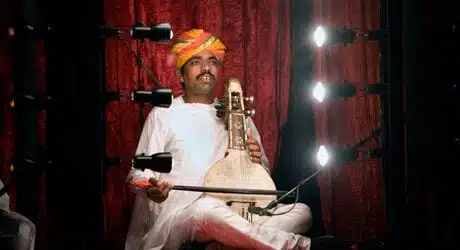
For the closing night event of its White Light Festival, Lincoln Center brought The Manganiyar Seduction (TMS) from Rajasthan, in northern India, over 7000 miles to the stage of the Rose Theater in Columbus Circle. Forty-two musicians, forty-one Muslims (“all Khans”) plus one Hindu led by director Roysten Abel, experienced the unsurprising challenge of obtaining US visas; the reason the event was delayed by five days from the original November 17-18th. Like the other event I witnessed during The White Light Festival, Credo, TMS was a performance with a unique spiritual expression and musical tradition. The Manganiyar Ensemble are a (mostly Muslim) group, who aren’t shy about worshipping Hindu gods and goddesses as well, and incorporate Indian classical music into major life moments.
This uniqueness was perceptible right from the moment one entered the theater. Unlike rows of chairs utilized in a traditional orchestra arrangement, a unique structure designed with thirty-six containers sat atop the stage, like an extended version of the Hollywood Squares box. A red curtain was drawn in front of each, hiding the contents from view. Eventually, as the performance began, the earnestly expressive, almost manic, conductor Daevo Khan stationed himself between the squares and the audience and the performance began as the curtain withdrew on one sole box.
The Manganiyars eased an unaccustomed audience in to their culture by systematically training their attention to each new instrument. Slowly, and continually building anticipation, curtains were pulled back and a new musician came into view. While each played, lights around his container went on, while those lights around silent instruments stayed off. The musicians continued like this for a while, slowly incorporating more instruments and singers into the composition and building cyclically around a Sufi traditional poem by Bulle Shah, “Alfat un bin in bin”. It felt scandalous to glimpse behind a curtain, like the red light district of Amsterdam that inspired it, but as the musical tapestry developed the audience succumbed to temptation and craved seeing more.
Eventually each capsule was opened and the tempo no longer allowed room for breath. The light bulbs flared on and off in dramatic fashion moving across, left to right and top to bottom, rapidly at points, meaning the musicians need to remain carefully synced to the conductor. Aside from a few boxes, at no point could the musicians see each other, they trusted in Khan’s guiding dance. They became a panopticon of exciting auditory stimulation to an audience straining to remain seated during the fantastic evening.

